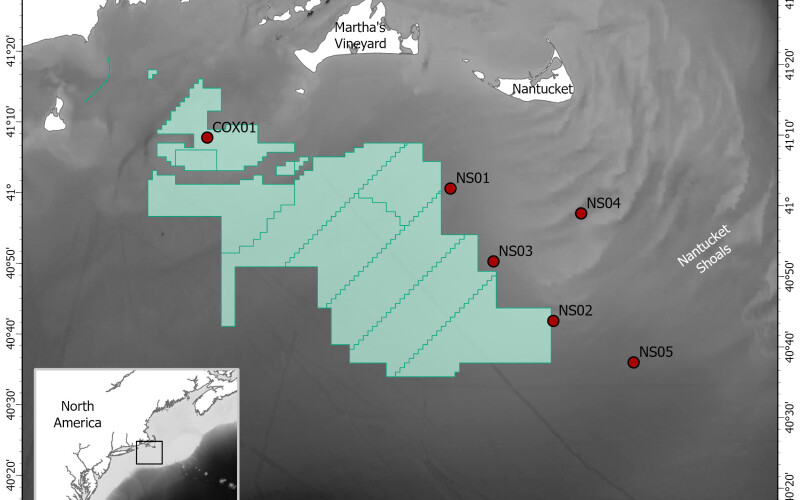A study by scientists with the National Oceanic and Atmospheric Administration recommends at least 24 hours of acoustic monitoring for detecting endangered North Atlantic right whales be completed before construction work at offshore wind energy construction sites. This is to reduce danger to the marine mammals from the loud undersea noise of pile driving.
Visual monitoring around work sites – with trained observers on vessels watching for whales – is one protocol with wind power companies and government regulators. Another is passive acoustic monitoring (PAM) which uses sensors to pick up and record whales’ vocalizations underwater.
Federal monitoring requirements now call for one hour of acoustic monitoring for whale activity before pile driving for turbine foundations. It is an “intense, impulsive noise that radiates into the surrounding environment as turbines are hammered into the sea floor,” the paper notes.
The study by a team at NOAA’s Northeast Fisheries Science Center, published Nov. 3 in the ICES Journal of Marine Science, calls for pushing out acoustic monitoring at least 24 hours ahead of construction schedules. Wind power turbines are now being erected on the Vineyard Wind and South Fork project sites off southern New England.
“Various effects on marine life have been observed from pile driving, ranging from avoidance to behavioral changes in harbor porpoises to displacement and physical injuries in fish,” the NOAA paper notes. “It is not yet known how pile driving will affect each species that has not yet been exposed to it.”
The NOAA research team reviewed recordings of right whale “upcalls” picked up from a network of underwater acoustic monitors off southern New England. The upcall, a low-frequency whoop, is roughly like a human “hello there,” that right whales use to communicate with other, said Genevieve Davis, a research biologists and acoustics specialist at the Northeast Fisheries Science Center in Woods Holes, Mass.
“They’re looking to see if other animals are around,” said Davis.
Davis and co-authors Sara Tennant and Sophie Van Parijs of NOAA’s Northeast passive acoustics branch the found that the now required one-hour window for listening for whale sounds will have only a 4% chance of hearing a right whale nearby. But expanding that listening period to 18 hours raises to 74% the likelihood that whale calls will ping on passive monitors –giving whale observers and construction crews more time to prepare and mitigate undersea noise that can affect the whales.
The study draws on a three-year database of whale calls continuously recorded from a network of six buoys off southern New England and archival recorders on the bottom to capture whale sounds. “Right now, we have about 40 to 50 sound traps along the coast,” said Davis. The resulting “baseline soundscape” is the first compiled in relation to U.S. offshore wind development areas.
Whale calls can typically be detected at a distance of 10 kilometers (5.4 nautical miles). Ideally a passive acoustic listening network for detecting whales around a project would be designed on a 20-kilometer grid to overlap coverage, the researchers said.

To reduce the loud noises of pile driving, developers are required to deploy bubble curtains, streams of compressed air pumped around turbine foundations to lessen the shock waves from hammering. Other noise sources are vessel traffic, subsea site work like boulder removal, and turbine operation.
With fewer than 350 animals left in the North Atlantic right whale population, the species is a top concern for marine mammal protections around wind power installations. For all mammals NOAA’s National Marine Fisheries Service has set levels for permitted “harassment” of animals from wind power operations; Level A is the potential for physical impact or injury, while Level B is defined as impact on animal behavior.
A series of mostly humpback whale strandings on New Jersey and New York beaches last winter led wind project opponents to charge that offshore acoustic seafloor surveys for the projects caused the whale deaths. Officials with NOAA and the Bureau of Offshore Energy Management insisted there is no known link.
There is little direct guidance on that issue from the European experience with offshore wind since the 1990s, in waters where harbor dolphins and porpoises are the dominant marine mammals.
Off the U.S. East Coast “we have a wider diversity of species, particularly these low-frequency (hearing) baleen whales” including humpbacks and right whales, said Van Parijs. But generally the effect of man-made undersea noise on whales is well-known, she said.
“There’s a large (scientific) literature on noise impacts. On cetaceans (whales, dolphins and porpoises) and baleen whales, there’s been a lot of studies. The noise criteria that NMFS develops in based on that, what we know about hearing ranges and hearing impacts,” said Van Parijs. “That’s why there’s those different levels for harassment.”
Vessels surveying offshore wind sites on the shallow East Coast continental shelf use sonar and other equipment that operate sounds at much lower volume than air guns used to probe for oil and gas deposits under deeper Gulf of Mexico waters, said Van Parijs.
Wind developers halt pile-driving activity from January to April, a time of wild North Atlantic weather and the peak period when right whales are on the move.
“We love this time of year, it’s when right whales are all over,” said Davis. “We’re just entering that wintertime period when they start to appear all along the coastline.”
“A longer monitoring period is clearly needed to provide ‘situational awareness’ in order to support a more robust mitigation approach” during turbine construction, the team’s paper advises.
Acoustic data from southern New England waters “shows that the longer you listen, the higher the likelihood of detecting an acoustically active” right whale, the researchers found. Another factor is that right whales’ calling behavior is lower and variable during the allowable pile-driving months of May through December.
During those months, “monitoring for at least 24 hours prior to activity is critical to increase the likelihood of detecting a North Atlantic right whale if they are in the area and upcalling,” the researchers concluded.




